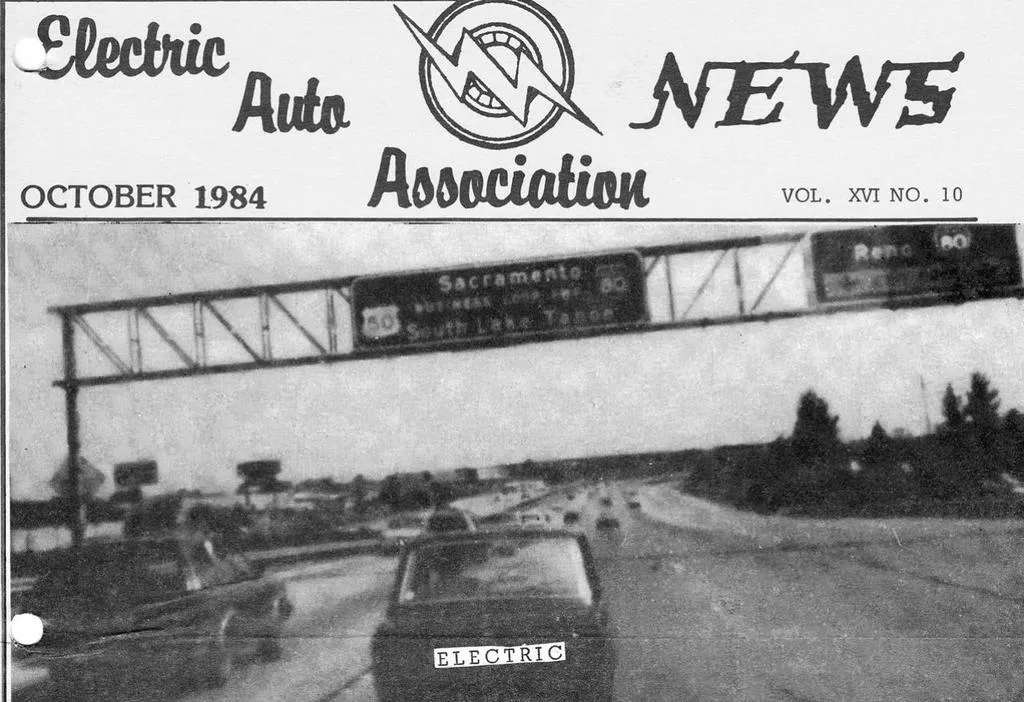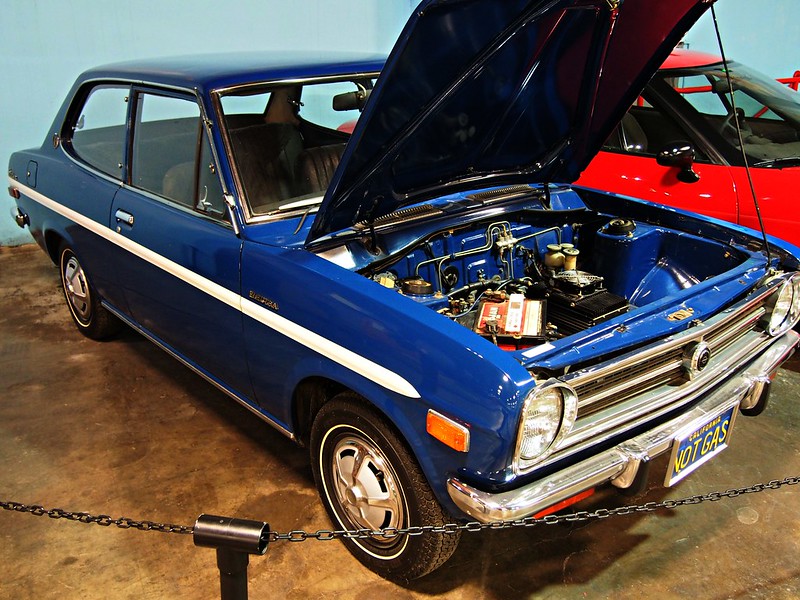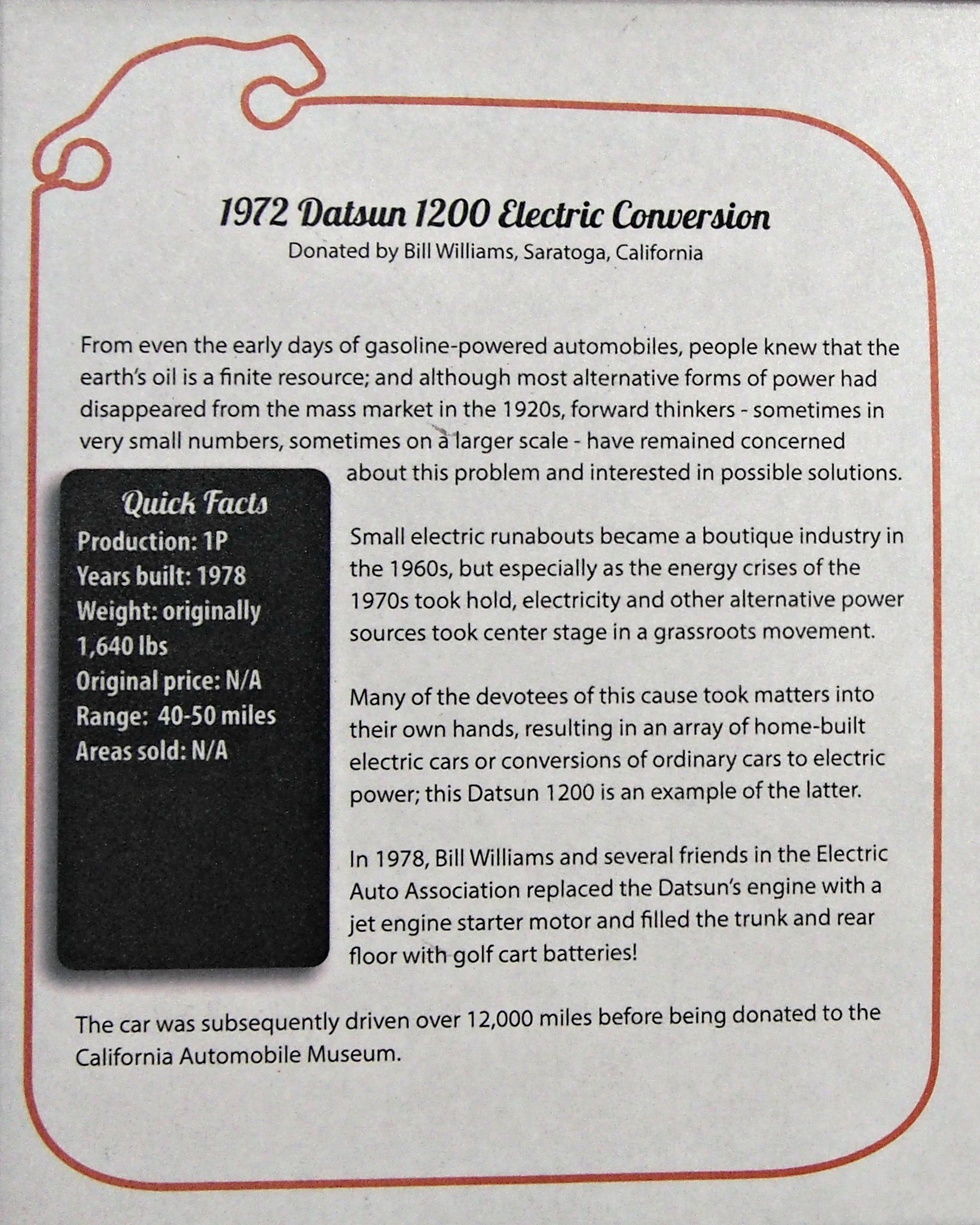Converted in 1978, this Datsun 1200 with 12,435 miles since conversion (now at 64,000+) is a unique, early example of a converted electric vehicle. The workmanship is impressive along with the history of the car participating in various events. This Datsun was also featured in the 1979 October issue of Popular Mechanics along with other publications in the Bay Area.
Contents |
Overview
1972 Datsun 1200 2-door sedan converted by Bill Williams
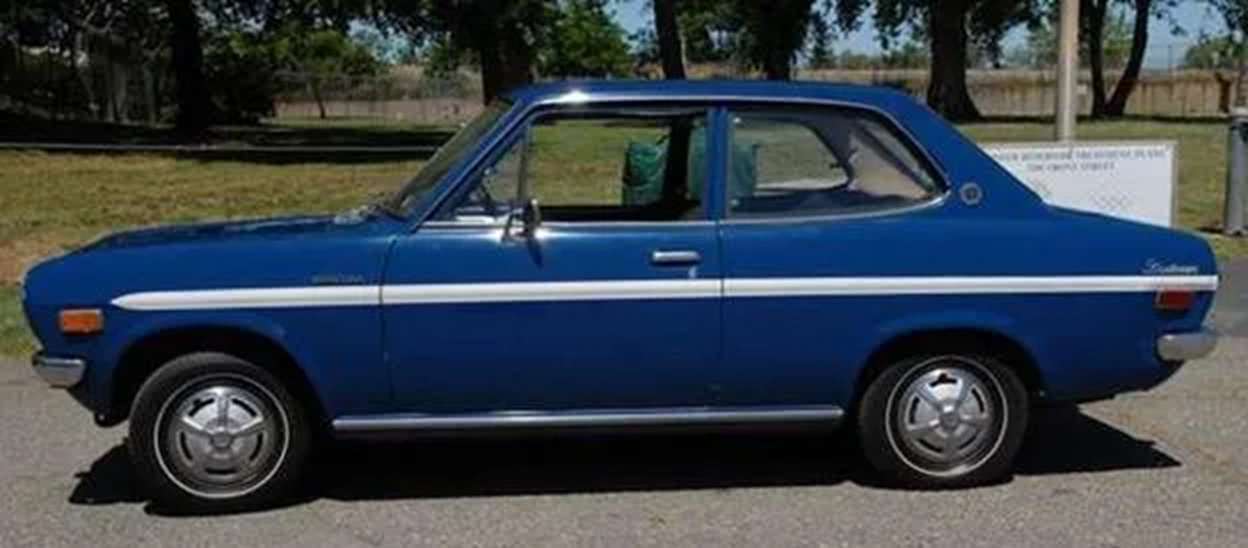
MEDIA:
- Hewlett-Packard Measure magazine "#We are driven - electrically!" (July, 1978) p. 13
- Popular Mechanics magazine #(October, 1979) p. 97
- San Jose Mercury News (August 20, 1980)
- Noon Day / KGSA, Channel 36, San Jose (9-3-80)
- Evening Magazine / KPIX, Channel 5, S.F. (11-10-80)
- PM Magazine / National Television (1-7-81ᴳ)
- Inducted into Towe Ford Museumᵂ (4-9-89)
AWARDS:
- Best Looking - 1978 Annual Electric Car Rally
- Most Practical - 1980 East Bay EAA Rally
CONVERSION COST: $1,871
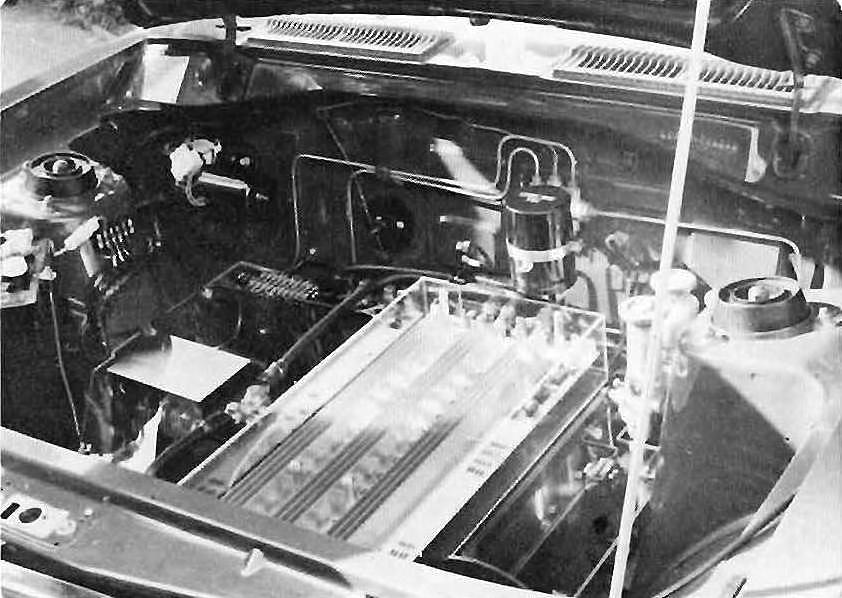
CONTROLLER: Curtis/PMC (Model 21) rated for Armature control of 84V/450A. IC Transistor (Pulse Width Modulated) with built-in current limiting, overload protection, free-wheeling diode, and temperature sensing.
CURB WEIGHT: 1587 lbs. as Gasoline Powered, 2322 as Electric.
TRANSMISSION: Standard original equipment (four speed with reverse). Adapter Plate and coupling by John Wasylina.
TIRES: Bridgestone 155SR12 (Whitewall Steel Belted Radials).
Measure Magazine
Hewlett-Packard Measure☁ magazine July, 1978 p. 13
We are driven - electrically!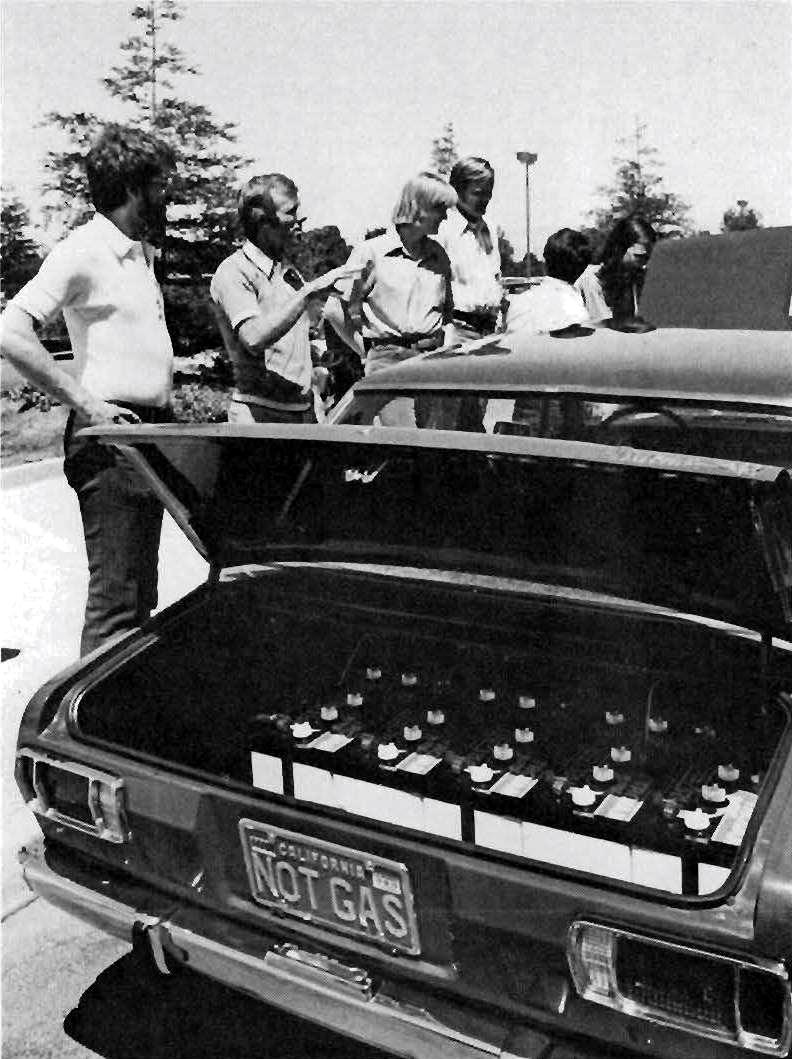
Borrowing the words from a current advertising slogan, you might say nobody demands more from a Datsun than — well, than HP's Bill Williams. Bill, a systems programmer at GSDᴳ, has just finished converting his 1972 model to run on store electricity rather than gasoline — a project started in late 1976. And if you ask him why he was willing to put 1152 man-hours of his own energy into producing an energy-efficient car, the answer you get is simple: "I was frustrated with the price of gasoline."It's not that the car was a bummer before. "I was getting outstanding gas mileage with it," Bill says. "In fact I was reluctant to tear a good car apart."
Still, the idea had been in the back of his mind since the gas crunch of 1974, when he began looking around for a better way of commuting. The obvious alternative vehicle, the bicycle, was not for him. "I broke my leg in a motorcycle accident in 1955," he explains, "so I was a little afraid of being exposed like that."
Bill noticed that the U.S. Postal Service was using some small electric vans. He enquired about them, and a helpful postal employee in Cupertino directed him to the Electric Auto Association☁. Through that organization he learned that he was not alone in what he was contemplating. "I found out that the technology existed and people had done it," he says. A whole world of electric car buffs — amateur automobile enineers, mechanics, weekend scientists and energy-conscious commuters like himself — was suddenly opened up to him.
The clincher came when the car blew a head gasket. Faced with $700 worth of repairs to the damaged engine, Bill reasoned that for a little more than that he could replace it with an electric system. (His final out-of-pocket expenses were over $1200, but he's recouping some of that by selling parts from the gasoline engine.)
Bill joined the Electric Auto Association and began swapping ideas with other members. None of the designs he looked at seemed suitable for his own project. ("Everybody does it his own way, and there were things I didn't like about most of the ones I saw.") But he began working with a retired engineer who was building a system, and when they had refined and tested it thoroughly, Bill began a similar one for his own car.
The motor is a 30-horsepower starter-generator. Top speed is 35 to 45 miles per hour, not likely to win any races. It's powered by 6-volt batteries which give it a range of 25 miles before recharging — plenty adequate for Bill's 12-mile daily commute to and from the new General Systems Division building on the Cupertino site. The controller for the system is a privately made kit. "I also designed the system to be adaptable whenever a better battery is made," says Bill, "or if something like solar power becomes practical."
The brakes and the rest of the drive train — clutch, transmission and drive shaft — are the original equipment. Bill also took the opportunity to painstakingly restore the automobile to like-new condition, so it now looks more like a "show" car than a commuting workhorse.
Bill is also working toward energy independence in other ways. He installed a solar heat system for his swimming pool, and he's investigating windmill power for some of his other energy needs. In those technologies, too, the serious amateurs seem to be leading the way in coming up with practical day-to-day application. And, like and good product designer — amateur or professional — Bill is already thinking about this "second generation" electric car.

Popular Mechanics October 1979
How I built my own electric car
by Bill Williams Popular Mechanics magazine, October 1979ᴳ

Eight of the 12 batteries are in the trunk.
This car's never waited on a gas line!
BUILD YOUR OWN ELECTRIC continued
What it's like to drive the Williams homebuilt electric_______________ by Michael Lamm WEST COAST EDITORBill Williams invited me over to drive his electric Datsun one sunny afternoon last June.
It takes no special training to drive an electric car, but you do develop a certain knack within a few blocks. "On level ground, get out of low gear as quickly as possible," Bill told me. This I did shifting to second after a short power burst.
Under hard acceleration, the pulse-width-modulated controller lets out a loud whistle, which I personally found distracting. But other drivers might enjoy it. It's louder than a turbocharger but in the same vein.
The converted Datsun accelerates with adequate briskness for all but the tightest situations. Within a few minutes, I learned how to enter busy thoroughfares. There's no problem keeping up with stop-and-go traffic. At red lights, everything shuts down — no waste of energy at all. Nothing "idles." Then when the signal turns green, down goes the accelerator and off goes the car — very smoothly, without click and jerks I've noticed in other electrics.
The Williams car cruises effortlessly in town at 40 mph. Bill has driven 55 on the freeway. The electric has a normal range of 40 miles when used around town.
I found the electric Datsun's worst enemy to be hills. Mild grades — those normal in city driving — offer no great challenge, although I did find myself speeding up or downshifting to third several times. On one particularly steep hill during our photo session, Bill needed to use second. Again, it's just a matter of learning the car's capabilities and then compensating. The transmission makes this vehicle much more flexible.
All in all, I came away from my drive with nothing but admiration for the car and its constructor. It's a beautifully neat, clean conversion — very professional. It costs about a penny a mile to run it. An overnight charge always leaves the batteries topped up.
Bill Williams commutes 12 miles a day to and from Hewlett-Packard. So, for his purposes, it's a perfect blend of economy, utility, performance and hobby. And never again will he have to wait on gas lines.
______________________________
SPECIFICATIONS — ELECTRIC CARMotor: General Electric 30-hp (d.c.) 2CM77 aircraft starter generator (with shunt field). About $300
Power: 72 volts (12 6-volt 244AH Trojan batteries). About $70@
Controller: 400-amp/72-volt IC/transistor, pulse-width-modulated; includes regenerative braking and field control. About $400.
Vehicle weight: 2280 pounds.
Range: 40 miles in city stop-and-go traffic.
Speed: 40 mph cruise, 55 mph max.

Electric Auto Conversion advertisement, 1981
classified advertisement from Popular Mechanics magazine, November 1980ᴳ page 219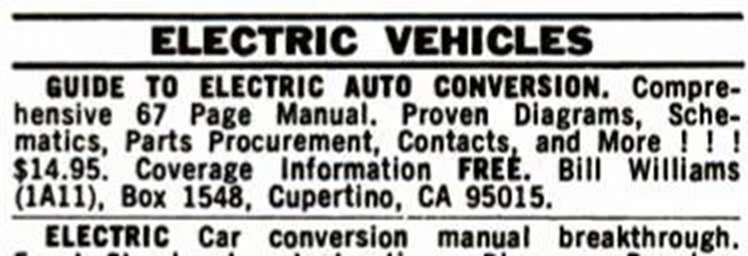
ELECTRIC VEHICLES
-----------------
GUIDE TO ELECTRIC AUTO CONVERSION. Comprehensive 67 Page Manual. Proven Diagrams, Schematics, Part Procurement, Contacts, and More ! ! ! $14.95. Coverage Information FREE. Bill Williams (1A11), Box 1548, Cupertino, CA 95015
California Automotive Museum
California Automotive Museumᴳ, Sacramento, California exhibit circa 2014
1972 Datsun 1200 Electric Conversion
Donated by Bill Williams, Saratoga, CaliforniaFrom even the early days of gasoline-powered automobiles, people knew that the earth's oil is a finite resource; and although most alternative forms of power had dissapeared from the mass market in the 1920s, forward thinkers - sometimes in very small numbers, sometime on a larger scale - have remained concerned about the problem and interested in possible solutions
Quick Facts
Production: 1P
Years built: 1978
Weight: originally 1,640 lbs
Original price: N/A
Range: 40-50 miles
Areas sold: N/ASmall electric runabouts became a boutique industry in the 1960s, but especially as the energy crises of the 1970s took hold, electricity and other alternative power sources took center stage in a grassroots movement.
Many of the devotees of this cause took matters into their own hands, resulting in an array of home-built electric cars or conversions of ordinary cars to electric power; this Datsun 1200 is an example of the latter.
In 1978, Bill Williams and several friends in the Electric Auto Association replaced the Datsun's engine with a jet engine starter motor and filled the trunk and rear floor with golf car batteries!
The car was subsequently driven over 12,000 miles before being donated to the California Automobile Museum.
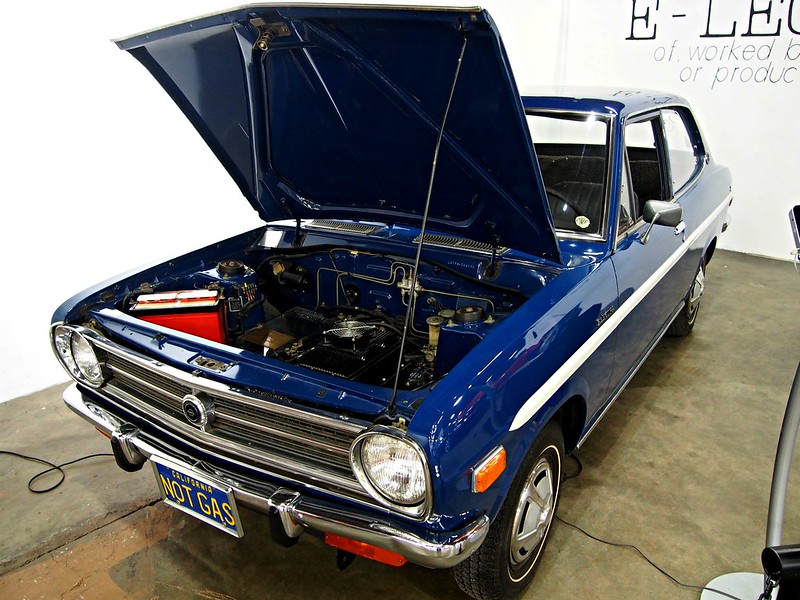
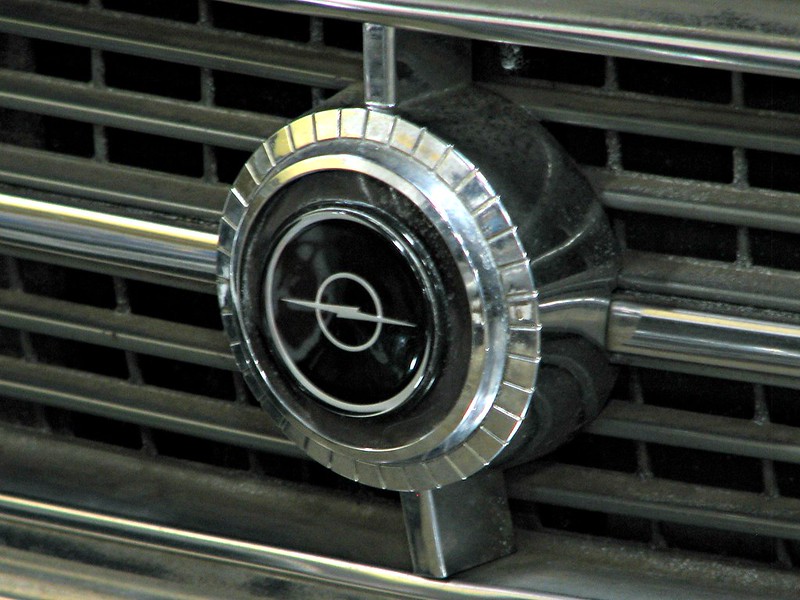
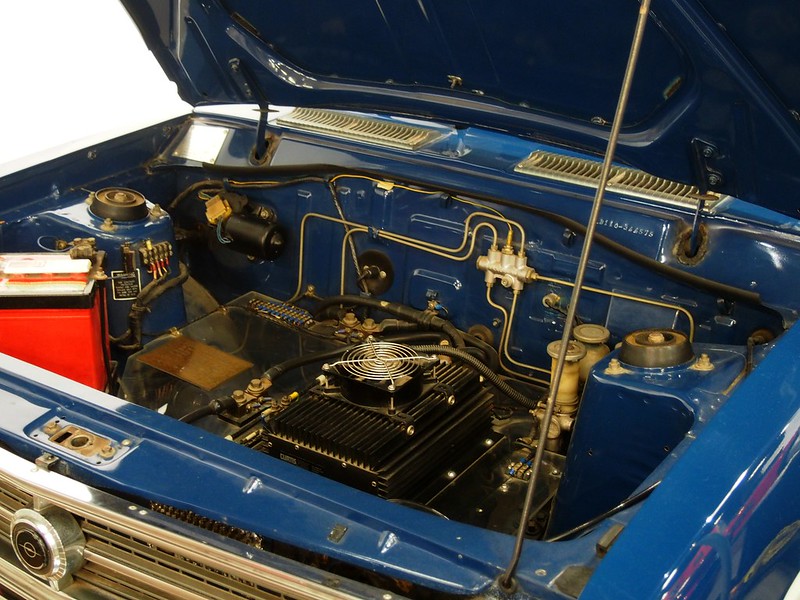

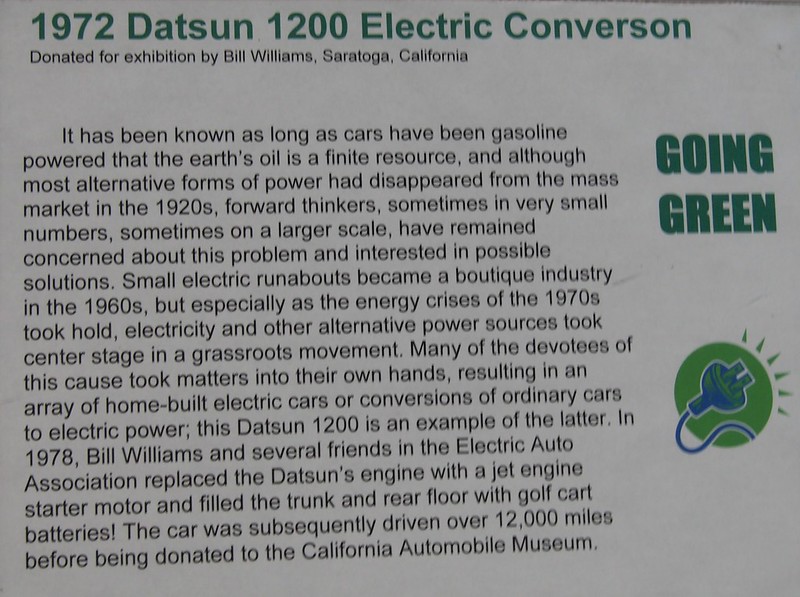
1972 Datsun 1200 Electric Conversion
Donated for exhibition by Bill Williams, Saratoga, CaliforniaGOING GREEN
It has been known as long as cars have been gasoline powered that the earth's oil is a finite resource, and although most alternative forms of power had dissapeared from the mass market in the 1920s, forward thinkers. sometimes in very small numbers, sometime on a larger scale, have remained concerned about the problem and interested in possible solutions. Small electric runabouts became a boutique industry in the 1960s, but especially as the energy crises of the 1970s took hold, electricity and other alternative power sources took center stage in a grassroots movement. Many of the devotees of this cause took matters into their own hands, resulting in an array of home-built electric cars or conversions of ordinary cars to electric power; this Datsun 1200 is an example of the latter. In 1978, Bill Williams and several friends in the Electric Auto Association replaced the Datsun's engine with a jet engine starter motor and filled the trunk and rear floor with golf car batteries! The car was subsequently driven over 12,000 miles before being donated to the California Automobile Museum.
2016 Sale
POST For Sale blue Datsun 1200 sedan electric power Sacramento, California USA
Sold for $3,350 USD, early 2016
Miles: 64,108
Offered for Sale by the California Automobile Museum1972 Datsun 1200 Electric Conversion
We Offer Financing
Exterior
Paint and body are in good condition with no damage found to body and only a few minor scratches in the paint.Interior
Interior is also in nice condition and is mostly original minus all of the additional meters for the electric conversion.Mechanical
Converted in 1978, with 12,435 miles since conversion, this is a unique, early example of a converted electric vehicle. While not in running condition the workmanship is impressive along with the history of the car participating in various events. This Datsun was also featured in the 1979 October issue of Popular Mechanics along with other publications in the bay areaᵂ.
This Datsun has been on display at the museum for a number of years and is no longer in operating condition. Brakes are also no longer working.
Exterior
This car's never waited on a gasoline line!





License number plate 'NOT GAS' issued by CALIFORNIA














Interior
Six batteries are in passenger compartment rear floor















1986 14th Annual SCEAA Electric Car Rally 1987 15th Annual SCEAA Electric Car Rally
Solar Car Project Stanford University Centennial Electric Vehicle Rally May 16, 1987
Hobbs hour meter, Stewart Warner instruments

Engine Compartment
Designer Plaque: Bill Williams, 7 May 1978


Engine compartment holds electric motor and controller.





![[Datsun 1200 encyclopedia]](/wiki/upload/wiki.png)
